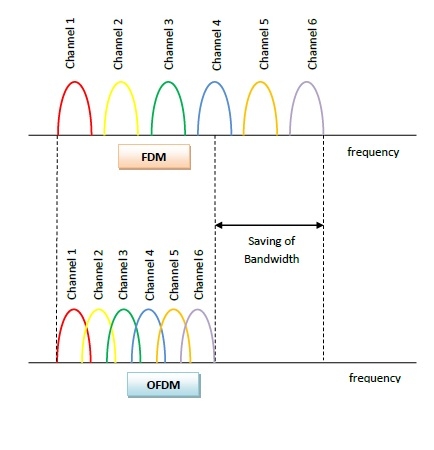
 Data Structure
Data Structure Networking
Networking RDBMS
RDBMS Operating System
Operating System Java
Java MS Excel
MS Excel iOS
iOS HTML
HTML CSS
CSS Android
Android Python
Python C Programming
C Programming C++
C++ C#
C# MongoDB
MongoDB MySQL
MySQL Javascript
Javascript PHP
PHP
- Selected Reading
- UPSC IAS Exams Notes
- Developer's Best Practices
- Questions and Answers
- Effective Resume Writing
- HR Interview Questions
- Computer Glossary
- Who is Who
Orthogonal Frequency Division Multiplexing (OFDM)
In data communications and networking, orthogonal frequency-division multiplexing (OFDM) is a method of digital data modulation, whereby a single stream of data is divided into several separate sub-streams for transmission via multiple channels.
OFDM uses the principle of frequency division multiplexing (FDM), where the available bandwidth is divided into a set of sub-streams having separate frequency bands. OFDM was introduced in 1966 by Chang at Bell Labs and was improved by Weinstein and Ebert in 1971.
Working Principle of OFDM
OFDM is a specialised FDM having the constraint that the sub-streams in which the main signal is divided, are orthogonal to each other. Orthogonal signals are signals that are perpendicular to each other. A main property of orthogonal signals is that they do not interfere with each other.
When any signal is modulated by the sender, its sidebands spread out either side. A receiver can successfully demodulate the data only if it receives the whole signal. In case of FDM, guard bands are inserted so that interference between the signals, resulting in cross-talks, does not occur. However, since orthogonal signals are used in OFDM, no interference occurs between the signals even if their sidebands overlap. So, guard bands can be removed, thus saving bandwidth. The criteria that needs to be maintained is that the carrier spacing should be equal to the reciprocal of the symbol period.
In order that OFDM works, there should be very accurate synchronization between the communicating nodes. If frequency deviation occurs in the sub-streams, they will not be orthogonal any more, due to which interference between the signals will occur.
The following diagram plots FDM versus OFDM, to depict the saving in bandwidth obtained by OFDM −

Usages
OFDM is used in the following area −
- Wi-Fi
- DSL internet access
- 4G wireless communications
- digital television
- radio broadcast services

